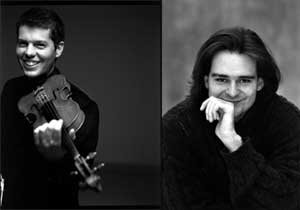|

Bold individuality
MALCOLM MILLER enjoys a performance by an outstanding young Hungarian duo at the Wallace Collection
The chance to hear promising new talent at the start of international careers has been a special feature of the Springboard Concerts series at the Wallace Collection since their inception. The second concert in the ninth series, on 23 November 2003, was no exception -- a sparkling recital by the youthful violin and piano duo of Barnábas Kelemen and Gergely Bogányi, given before a capacity audience in the Long Gallery of the Wallace Collection in Manchester Square, central London. Kelemen, who has worked with leading violinists of our time including Isaac Stern, György Pauk and Thomas Zehetmair, is a young artist of bold individuality, elegantly attired in a Hungarian-style designer jacket, and enveloped with concentrated intensity during his performance of a demanding, and rewarding programme.
Liszt is a composer seldom associated with solo violin music, yet the two short works which launched the programme showed his poetic romanticism idiomatically assigned to this lyrical instrument. Kelemen brought passion and evocative poetry to the arch form of the Romance oubliée, a work of Liszt's old age which nostalgically revisits an early song and piano Romance from his virtuoso years. And the duo captured the elusive evanescence of the angelic Benedictus from the Hungarian Coronation Mass which Liszt composed for the 1867 coronation of the Austro-Hungarian Emperor Franz Joseph. The tour de force of the recital was Kelemen's intensely engaging account of one of the masterpieces of the modern unaccompanied violin repertoire, Bela Bartók's Sonata for Solo Violin, one of the composer's last works, composed in America for Yehudi Menuhin, who premièred it at Carnegie Hall in 1944. Though not expressly based on Hungarian folk songs, there is a strong Hungarian character to the harmony and the finale features czardas-like dances in its episodes. A virtuoso feat for any violinist, Kelemen rose to its technical and artistic challenges, articulating a large-scale drama amongst and within each of the four movements. The first movement's contrasts were coloured and sculpted with extraordinary atmosphere, the second subject's insistent pedal note, and the fiery climaxes before the subdued conclusion. The fugal second movement flowed with discipline and rich polyphonic sonorities, while the tender, trill veiled mood of the third movement 'Melodia' gave way to the urgently buzzing rondo finale, with its sturdy Hungarian episodes. One sensed here that Kelemen was speaking to the audience with intense inner conviction, his rich sound benefiting from the Stradivarius instrument he plays as part of his prize for the 2002 Indianapolis International Violin Competition. This was a performance that expressed something intensely personal, and therefore conveyed its abstract modernism with immediacy and appeal.

The youthful Hungarian violin/piano duo Barnábas Kelemen and Gergely Bogányi
|
The final work, the more familiar Franck Sonata, was performed with eloquence and passion, the duo displaying their musical qualities including a wide dynamic range, and combination of firmness and supple expressive playing in the violin, supported by Boganyi's clarity of texture in the gracefully realised piano part. Everything flowed with ease and buoyancy especially the finale, following a rhapsodic slow movement, and bubbling second movement conveyed with an exciting balance of delicacy and rhythmic bite. Yet the peak of Kelemen's zest and virtuosity was reserved for the charming encore, Sarasate's Gypsy Air, which dazzled and delighted to round off his début recital with precision and panache. It was clearly a display of outstanding promise that one hopes to hear develop in future concerts by these young artists.
|